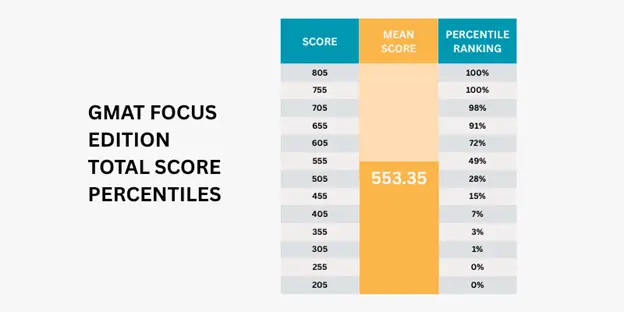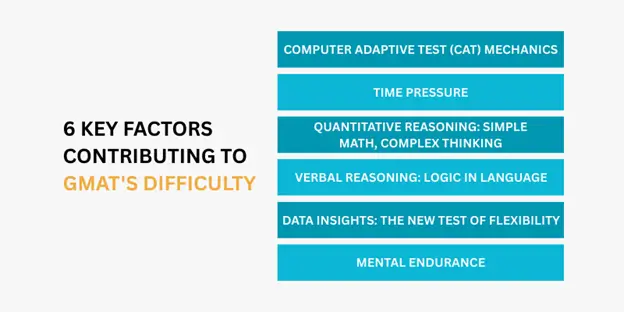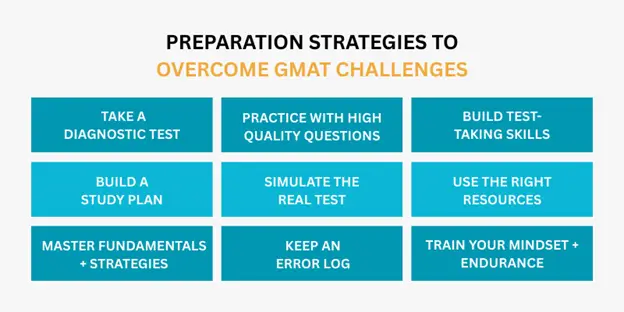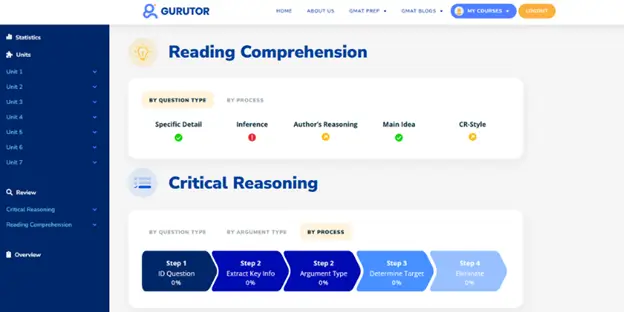How Hard is the GMAT?

How hard is the GMAT? If you’re asking, you’re already thinking like a serious applicant.
The Graduate Management Admission Test (GMAT) is designed to be challenging, as it plays a crucial role in securing admission to top business schools.
And with the new GMAT Focus Edition, the format may be structured, but the core remains: it still measures how well you can think, adapt, and perform under pressure.
Interestingly, once you understand why the GMAT feels hard, you can target those exact challenges and prepare with precision.
In this guide, we’ll break down what makes the GMAT difficult and how you can overcome the weak areas through smart GMAT prep strategies.
Also, we’ll explain how Gurutor’s structured GMAT prep approach, with adaptive learning, tutor-style feedback, and a system designed for efficiency, turns those challenges into strengths.
Understanding the GMAT Difficulty Level
Just how difficult is the GMAT? The answer depends on your background and preparation.
However, to really understand why the GMAT feels hard, you need to see how the GMAT Focus Edition is built.
Scoring System — the Baseline Every Applicant Should Know
Unlike the old version, the GMAT score distribution is divided into three sections: Quantitative Reasoning, Verbal Reasoning, and Data Insights, each 45 minutes long.
The GMAT’s current total score scale is 205–805, with total scores reported in 10-point increments and section scores in 1-point increments on a 60–90 scale.
Because the scoring model now weights Quant, Verbal, and Data Insights equally, the test rewards balance: you can’t ignore a section and expect a top total.
Average Scores — Where Most Test-Takers Sit
The GMAT is designed to spread test-takers along a curve.
The average sits in the mid-500s. Scoring around 555 puts you at the 50th percentile, better than half of all test-takers.

However, the 90th percentile is substantially higher and requires focused preparation.
- To break into the top 25%, you’d need a score of about 605.
- To hit the top 10%, you’re looking at 655 or more.
If you’re aiming for top programs, you’re not targeting “average.” You’re targeting percentiles, often the 90th percentile and above, for top MBA classes.
Percentiles — Why they Matter More than Raw Scores
GMAT Percentiles tell schools how you performed relative to other applicants.
For example, a 75th percentile score means you’ve outperformed 75% of test-takers, while 25% still scored higher.
At the section level, the same rules apply. A Quant score of 90 puts you at the very top; nearly no one gets there, while an average Quant score is closer to 78.
Data Insights trends slightly lower, with averages around 75. That means even a few points above average can significantly shift your percentile.
6 Key Factors Contributing to GMAT’s Difficulty

There’s a difference between hard content and testing difficulty.
The GMAT’s challenge is largely in the test design. Here are the main contributors:
1. Computer Adaptive Test (CAT) Mechanics
The GMAT adapts to you in real time.
Answer correctly, and the next question gets harder; answer incorrectly, and it adjusts down.
You can’t skip, you can’t go back, you’re forced to commit on the spot.
This format creates a unique kind of pressure: not knowing how you’re doing while knowing every choice matters.
Unlike the GRE or LSAT, there’s no circling back to a tough question later. Success requires resilience, pacing, and trust in your process.
2. Time Pressure
On average, you get just under two minutes per question.
That doesn’t sound terrible, until you realize most GMAT problems are multi-step puzzles.
Quant and Data Insights questions often hide the solution behind tricky wording or layered reasoning. The challenge isn’t just accuracy, it’s accuracy at speed.
Thus, learning when to let go of a tough question, make an educated guess, and move forward is a survival skill.
3. Quantitative Reasoning: Simple Math, Complex Thinking
GMAT Quant doesn’t test calculus or advanced math; it’s high-school level.
But the test twists simple math into real-world word problems, logic puzzles, and the infamous Data Sufficiency format.
The difficulty isn’t solving equations, it’s figuring out what’s being asked in the first place, and doing it quickly.
That said, the GMAT turns “easy math” into a thinking challenge, rewarding calm, systematic problem-solving.
4. Verbal Reasoning: Logic in Language
The Verbal section isn’t about memorizing vocabulary; it’s about critical reading and reasoning.
You’ll need to:
- Break down dense Reading Comprehension passages,
- Strengthen or weaken arguments in Critical Reasoning, and
- Spot subtle grammar and clarity issues in Sentence Correction.
The real trap? The wrong answers often sound right.
5. Data Insights: The New Test of Flexibility
The Data Insights section replaces Integrated Reasoning in the Focus Edition.
It blends Quant and Verbal skills, including interpreting charts, analyzing tables, solving two-part logic problems, and comparing multi-source data.
The hard part isn’t deep math, it’s switching gears quickly between formats.
6. Mental Endurance
Even at 2 hours and 15 minutes, the GMAT is a grind.
Switching constantly between math, logic, reading, and data interpretation takes focus.
The test also punishes lapses in attention, one careless mistake can cost you percentile points.
On top of that, the psychological weight of the adaptive format and time pressure makes stress management part of the game.
The Core Truth About GMAT Difficulty
The GMAT isn’t hard because of tricky formulas or obscure grammar rules.
It’s hard because it’s built to test the exact skills business school cares about: clear thinking, sharp decision-making, and composure under pressure.
In other words, it’s less about what you know and more about how you perform.
With the right structure, you can learn to pace yourself. And this is exactly where Gurutor comes in.
Instead of throwing endless practice questions at you, Gurutor teaches you how to think like a top scorer: a step-by-step process, real-time feedback on your mistakes, and a system that builds the habits you’ll need on test day.
It’s prep designed not just to teach, but to actually raise your score.
Comparing GMAT with Other Exams
How does the GMAT compare to other big exams like the GRE (Graduate Record Examination) or the LSAT (Law School Admission Test)?
Many MBA hopefuls ask whether it’s harder or easier.
GMAT vs. GRE
Which exam is more challenging? It depends on you.
The GMAT is designed for business school, testing skills such as data interpretation and decision-making that directly mirror MBA coursework.
The GRE is broader; its Quant is often seen as easier, but its Verbal can be tougher.
For MBA applicants, the GMAT aligns more closely with what schools value, while the GRE may be a better fit for those with strong vocabulary or who prefer its format.
Here’s a quick comparison:
| Feature | GMAT Focus Edition | GRE General Test |
| Purpose | Built specifically for MBA admissions | General grad school test (accepted for MBA, but not designed for it) |
| Global Acceptance | Accepted by 7,700+ programs worldwide | Accepted by around 1,300 business schools |
| Format | 3 sections: Quant, Verbal, Data Insights. No essay. Adaptive per question. | 3 sections: Quant, Verbal, + 2 essays. Adaptive per section. |
| Timing | ~2 hours 15 minutes (+ optional break) | Just under 2 hours (new 2023 format) |
| Quant Difficulty | Logic-heavy, data-focused, includes Data Sufficiency | More straightforward, slightly more geometry |
| Verbal Focus | Grammar (Sentence Correction) + Logical Reasoning | Heavy vocabulary (Text Completion, Sentence Equivalence) |
| Scoring | 205–805 (all scores end in “5”) | Quant + Verbal each 130–170, combined out of 340 + essays scored 0–6 |
GMAT vs. LSAT
The GMAT is a balanced test that blends math, verbal reasoning, and business context.
The LSAT, on the other hand, is a test of pure logic, reading, and critical thinking, with no math involved.
Both are tough, but in different ways.
The GMAT puts time pressure on Quant, whereas the LSAT requires nearly perfect performance across the board due to its steep scoring curve.
| Feature | GMAT (Focus Edition) | LSAT |
| Purpose | MBA / business school admissions | JD / law school admissions |
| Sections | Quantitative Reasoning, Verbal Reasoning, Data Insights | Logical Reasoning (x2), Analytical Reasoning (Logic Games), Reading Comprehension, + unscored writing & experimental |
| Exam Length | 2 hrs 15 mins | 2 hrs 55 mins |
| Math Content | Yes – arithmetic, algebra, data analysis, logic | None – 100% logic, reasoning, and reading |
| Adaptivity | Computer-adaptive by question | Fixed format (not adaptive); same difficulty mix for all |
| Question Review | No skipping/returning | Can skip & return within section |
| Timing Pressure | Moderate (avg. ~2 min per question) | Very tight (avg. ~1.4 min per Logical Reasoning Q) |
| Scoring | 205–805 total (scaled from 3 sections) | 120–180; extremely steep curve (few errors allowed at top scores) |
| Perceived Difficulty | Challenging, especially Quant reasoning under adaptive pressure | Considered tougher overall: high precision required, especially in Logic Games & dense Reading Comp |
| Admissions Use | Widely accepted by MBA programs worldwide | Required for law school |
Preparation Strategies to Overcome GMAT Challenges

Thousands of students raise their scores every year, not through luck, but through smart preparation, structured study, and consistent practice.
Here’s how to prepare and tackle the GMAT like a pro:
1. Take a Diagnostic Test
Start with a baseline. Use the free GMAT Starter Kit (2 full practice tests) to see where you stand.
Don’t obsess over the score; instead, identify patterns: Are you strong in Quant but shaky in Verbal inference? Or vice versa?
This first test gives you a map for your journey.
2. Build a Study Plan
Based on your timeline and diagnostic results, create a realistic weekly GMAT study plan (e.g., Week 1– 2: Algebra and Arithmetic; Week 3: Critical Reasoning).
Focus on weak spots, but also continue to practice your strengths.
For this, consistency beats cramming, as two focused hours daily over eight weeks works better than marathon weekend sessions.
3. Master Fundamentals + Strategies
Before grinding practice questions, nail the basics:
- Math: algebra, arithmetic, geometry, probability.
- Verbal: grammar rules, sentence structure, idioms.
- Strategies: data sufficiency shortcuts, elimination in sentence correction, argument patterns in CR.
Every time you learn a concept, reinforce it with targeted practice. The GMAT is about knowing what the question is really asking.
4. Practice with High-Quality Questions
Use official GMAT problems whenever possible.
When you miss a question, review deeply:
- Why is the right answer right?
- Why were the wrong ones tempting?
Spot them early, and the test gets easier.
5. Simulate the Real Test
Take full-length practice tests every 2–3 weeks.
Replicate test conditions: no extra breaks, no calculator for Quant.
For example, are you burning time on Reading Comp? Struggling with Probability? Adjust your prep accordingly.
By test day, the real thing should feel like “just another practice run.”
6. Keep an Error Log
Track every mistake, the reason behind it, and the fix.
Over time, you’ll see patterns: misreading stems, falling for traps, running out of time.
Review the log weekly to turn mistakes into future points.
7. Build Test-Taking Skills
The GMAT is about skill, not just knowledge. Train yourself to:
- Make quick eliminations.
- Pick numbers in abstract algebra problems.
- Skim Reading Comp for structure, not detail.
- Extract data fast from charts/tables.
Build a personal toolkit so every question type feels familiar.
8. Use the Right Resources
Stick to a trusted prep resource: GMAT Official Guide. Avoid low-quality freebies.
If you need structure or accountability, a course or tutor can help, but Gurutor goes further.
Unlike a tutor who might have an off day, Gurutor is always there, correcting you mid-practice and keeping your prep on track.
And because it’s self-paced, you get expert-level guidance whenever you need it, without wasting months on inefficient habits.
9. Train Your Mindset + Endurance
Build focus by practicing two sections back-to-back.
Prioritize sleep, exercise, and nutrition as they’re underrated score boosters.
Remember, confidence and calm often make as much difference as formulas and grammar rules.
Gurutor’s Role in Your GMAT Success
Gurutor is not “just another course.”
It’s a self-paced, adaptive GMAT prep platform designed to help ambitious GMAT takers attempt the test with confidence.
The system is personal, flexible, and results-driven, providing everything you actually need to go from stuck to scoring high.

Here’s how Gurutor works:
- Official & Curated Content
You’ll study with official GMAT questions and expert-designed drills, so every practice session reflects the real exam.
- Structured, Self-Paced System
Practice is organized to give clarity and direction without overwhelming you.
- Always-On Guidance
Unlike human tutors who may forget, become fatigued, or experience scheduling conflicts, Gurutor never has an “off” day.
- Efficient Learning
Say goodbye to 100,000-question rabbit holes; every session targets progress, not busywork.
- Built for Real Improvement
You’re not just watching videos or memorizing shortcuts; you’re actively learning, correcting mistakes, and building lasting skills.
- Every Hour Counts
With no wasted content and no overstudying, your time investment delivers maximum return.
- 24/7 Access
Whether it’s early morning or late at night, Gurutor is ready when you are.
With Gurutor, your prep is no longer about “putting in hours,” it’s about making every hour move you closer to your target GMAT score.
FAQs about GMAT Difficulty
How Difficult is the GMAT?
The GMAT is a challenging entrance exam for graduate school. Lasting just 2 hours and 15 minutes, it tests your quantitative skills, command of verbal reasoning, and ability to analyze data under pressure.
What Makes the GMAT Difficult for Most Test-Takers?
Time pressure is one of the biggest challenges. You need to solve tough problems quickly, especially in the Quantitative and Data Insights sections. On top of that, adjusting to the adaptive format and the new 205–805 scoring scale can make the test feel even more demanding.
Is the GMAT Difficult to Pass?
The GMAT’s difficulty largely depends on how well you prepare and how comfortable you are with the test format. Many find it challenging due to the strict timing and diverse question types. Still, with targeted practice and consistent study, most test-takers can achieve a competitive score.
Ready to Turn the GMAT from Hard to Your Competitive Edge?
Start today and see how structured, always-on guidance can transform your prep into real results.
